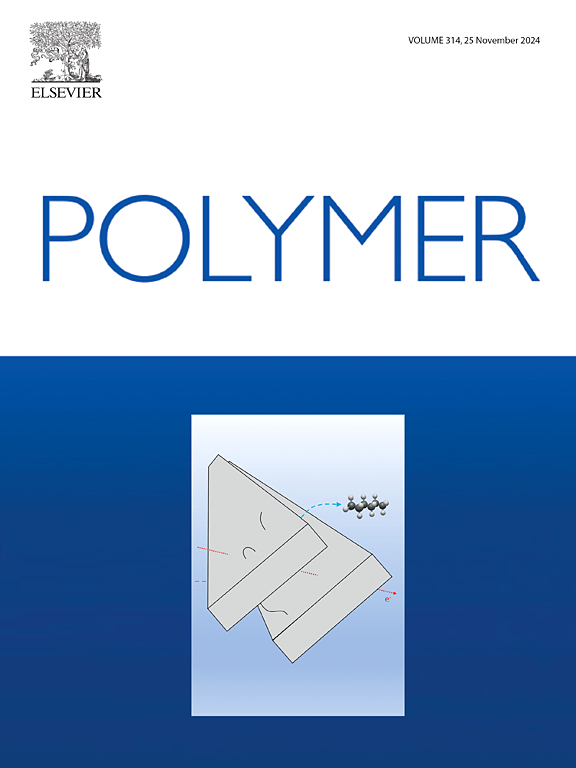聚苯硫醚泡沫珠发泡成型界面增强结构的构建
IF 4.1
2区 化学
Q2 POLYMER SCIENCE
引用次数: 0
摘要
聚苯硫醚(PPS)是一种应用最广泛的特种工程塑料,其发泡研究对扩大其应用范围,满足航空航天、汽车等领域的要求具有重要意义。本文首次采用表面约束sc-CO2发泡法制备了无皮PPS泡沫珠(S-PPS)。与常规PPS泡沫珠相比,S-PPS泡沫珠完全消除了固体表皮层,呈现出明显的蜂窝状多孔结构,表面细胞密度甚至高于核心层。在此基础上,以环氧树脂(EP)为界面粘接层,采用泡沫珠表面粘接辅助成型的方法制备了pps基泡沫塑料。加入EP原因的泡沫珠的表面亲和性和粘附强度通过表面多孔结构的形成而增强,而与具有清晰粘附界面的规则PPS@EP泡沫珠相比,S-PPS@EP泡沫珠的EP相渗透并锚定在S-PPS珠表面的微孔中,形成了牢固的机械互锁结构;显著增强了两相之间的界面物理和化学相互作用,从而提高了粘合泡沫样品的整体力学性能。随着粘结剂含量和界面层厚度的增加,两种试样的抗压性能差异逐渐扩大。具体来说,S-PPS@EP泡沫试样的抗压强度比PPS@EP泡沫试样提高了约42%。本工作为特种工程塑料泡沫的制备提供了一种新的策略。本文章由计算机程序翻译,如有差异,请以英文原文为准。


Construction of interfacial reinforcement structure of polyphenylene sulfide foam for bead foaming molding
Polyphenylene sulfide (PPS) is a most widely used special engineering plastic, while the foam research is of great significance to expand its application and meet the requirements in aerospace, automobile, etc. In this work, the skinless PPS foam bead (S-PPS) was first prepared by surface-constrained sc-CO2 foaming method. Compared with the regular PPS foam bead, the solid skin layer of S-PPS foam bead is completely eliminated, exhibiting obvious honeycomb porous structure, while the cell density of the surface was even higher than that of the core layer. Furthermore, PPS-based foam was prepared with the surface adhesion-assisted molding method of foam beads by using epoxy resin (EP) as the interfacial adhesive layer. The surface affinity and adhesion strength of foam bead with EP reasin was enhanced by formation of surface porous structure, while compared with regular PPS@EP foam with clear adhesion interface between the foam beads and EP phase, for S-PPS@EP foam, the EP phase penetrated and anchored into the micropores on the surface of S-PPS beads, forming a strong mechanically interlocked structure, significantly enhancing both interfacial physical and chemical interactions between the two phases and thereby improving the overall mechanical performance of the bonded foam samples. With increasing adhesive content and interfacial layer thickness, the difference in compressive property between the two types of samples progressively widened. Specifically, the compressive strength of the S-PPS@EP foam samples was improved by approximately 42 % compared to the PPS@EP foam samples. This work provides a novel strategy for preparing special engineering plastic foam.
求助全文
通过发布文献求助,成功后即可免费获取论文全文。
去求助
来源期刊

Polymer
化学-高分子科学
CiteScore
7.90
自引率
8.70%
发文量
959
审稿时长
32 days
期刊介绍:
Polymer is an interdisciplinary journal dedicated to publishing innovative and significant advances in Polymer Physics, Chemistry and Technology. We welcome submissions on polymer hybrids, nanocomposites, characterisation and self-assembly. Polymer also publishes work on the technological application of polymers in energy and optoelectronics.
The main scope is covered but not limited to the following core areas:
Polymer Materials
Nanocomposites and hybrid nanomaterials
Polymer blends, films, fibres, networks and porous materials
Physical Characterization
Characterisation, modelling and simulation* of molecular and materials properties in bulk, solution, and thin films
Polymer Engineering
Advanced multiscale processing methods
Polymer Synthesis, Modification and Self-assembly
Including designer polymer architectures, mechanisms and kinetics, and supramolecular polymerization
Technological Applications
Polymers for energy generation and storage
Polymer membranes for separation technology
Polymers for opto- and microelectronics.
 求助内容:
求助内容: 应助结果提醒方式:
应助结果提醒方式:


